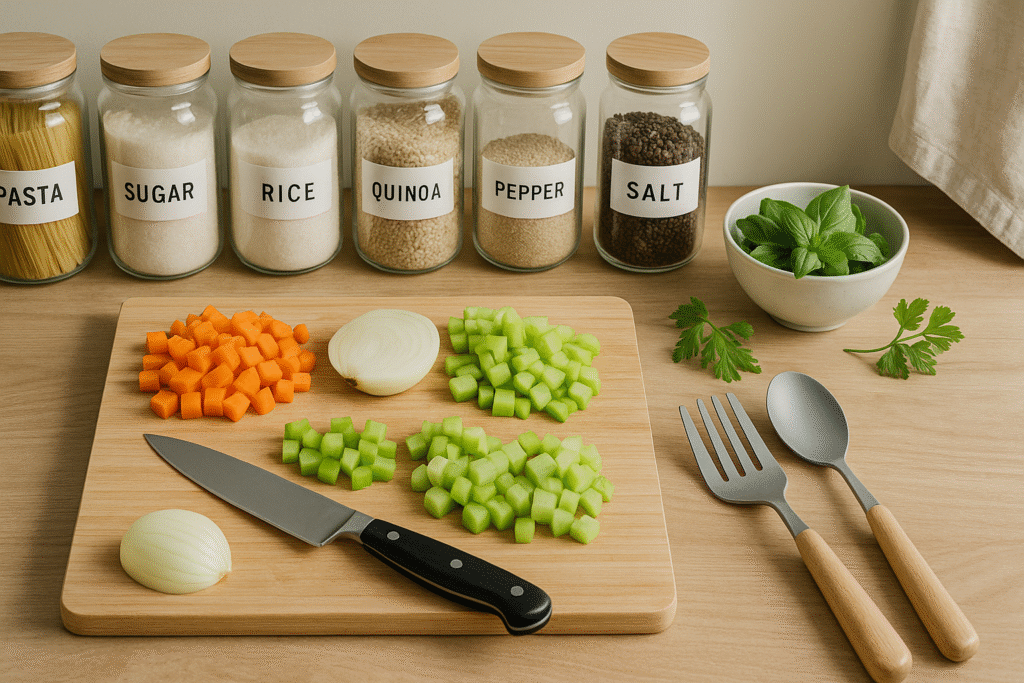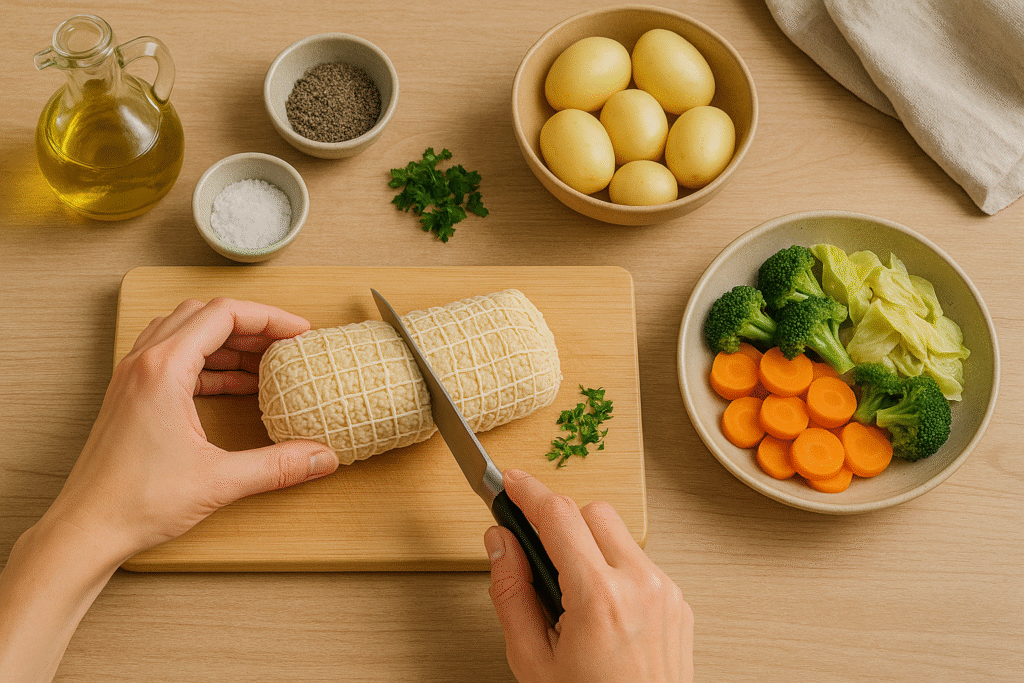
What this page is all about – 10-sentence preview
- Welcome to Tips & Hacks, the busy cook’s toolbox on easy.recipescooking.blog.
- Here you’ll discover clever shortcuts that shave minutes off prep-time without sacrificing flavor.
- We break down kitchen science into bite-size tricks you can apply tonight, even if you’re brand-new to cooking.
- From zero-waste produce storage to fool-proof seasoning formulas, every hack is tested in a real home kitchen.
- You’ll also get printable cheat-sheets, step-by-step photo guides, and quick-view videos to keep at your fingertips.
- Our insider equipment reviews help you decide which gadgets are worth the counter space.
- Meal-prep roadmaps show you how to batch-cook for the week and still keep things fresh and exciting.
- We sprinkle in pro-level flavor boosts—like balancing acid, heat, and umami—so your “easy” dinners taste restaurant-worthy.
- Sustainability matters, so you’ll learn earth-friendly storage and cleaning tricks that save money, too.
- Bookmark this hub and check back often; we add new hacks every Monday so your kitchen game never stops leveling up!

50 Essential Kitchen Tips & Hacks to Make Cooking Faster, Easier, and More Delicious
Table of Contents
- Why Smart Hacks Beat Hard Work
- Pantry & Fridge Organization Hacks
- Time-Saving Prep Techniques
- Flavor-Boosting Secrets
- One-Pot & Sheet-Pan Mastery
- Equipment Upgrades That Earn Their Keep
- Cleaning & Maintenance Shortcuts
- Sustainable Cooking: Waste Less, Save More
- Meal-Prep & Freezer-Friendly Systems
- Quick-Reference Cheat Sheets & Printables
- Final Thoughts: Build Your Own Hack Stack
1 | Why Smart Hacks Beat Hard Work
Cooking from scratch is deeply rewarding, but between work, family, and that ever-growing to-do list it can also feel overwhelming. Hacks are not about cutting corners in a careless way; they’re mini-systems that remove friction, letting you focus on the fun parts—flavor, creativity, sharing meals. Neuroscience tells us that whenever we replace a multi-step task with a streamlined routine, we conserve will-power and reduce decision fatigue. Imagine walking into a tidy kitchen where every tool lives exactly where you expect it to be, ingredients are pre-portioned, and a pot is already simmering—your future self says thank you.
That’s the philosophy behind this guide: front-load a little thinking, gain hours in return, and turn “What’s for dinner?” from a stress-question into an invitation to play.
2 | Pantry & Fridge Organization Hacks
Clear containers are your new best friend. Transfer bulk dry goods—rice, quinoa, pasta, lentils—into air-tight glass jars. You’ll instantly see inventory levels and reduce pests. Label the bottoms with cooking ratios (e.g., “1 cup quinoa : 1¾ cups water, 15 min”). Next, adopt the First-In-First-Out (FIFO) rule: slide new groceries behind older ones so nothing expires unseen.
The “Door Danger Zone”
Fridge doors fluctuate in temperature. Keep condiments there, but move milk, raw meat, and fresh herbs to the mid-shelf sweet spot (below 40 °F). For produce, line crispers with reusable cloths—excess moisture is the enemy of crunch.
The 5-Zone Pantry Map
- Daily Zone: coffee, oats, nut butter—eye level.
- Quick-Dinner Zone: canned beans, coconut milk, marinara—lower shelf.
- Baking Zone: flours, sugars, yeast—cool, back corner.
- Flavor Bomb Zone: spices, sauces—dedicate a lazy-Susan.
- Overflow Zone: bulk paper goods—top shelf or separate closet.
Color-code shelf edges with removable tape so family members can find (and return!) items without asking.
3 | Time-Saving Prep Techniques
Mise en Place Lite
Professional chefs swear by mise en place—“everything in its place.” For home cooks, 15-minute micro-mise sets you up: dice aromatics, measure spices, and position pans before turning on the heat. Use a rimmed sheet pan as your staging tray; it corrals stray garlic cloves and carries everything to the stove in one trip.
Two-Board Method
Reserve one cutting board for raw proteins and another for produce to prevent cross-contamination and avoid washing mid-recipe. Bonus: choose contrasting colors (wood + polypropylene) so you never mix them up.
The 30-Second Garlic Peel
Crush cloves lightly under the flat of a knife, toss them into a small lidded jar, and shake vigorously. Skins slip off, fingers stay odor-free.
Batch-Chop Veggies
While your knife is out, slice extra onions, carrots, and bell peppers. Store in airtight containers for up to five days; you’ve just bought future you a head start. Pro tip: place a folded paper towel in the container to absorb moisture and keep textures crisp.
4 | Flavor-Boosting Secrets
Great meals ride on layered seasoning, not extra effort.
- Salt Early & Often: Season proteins as soon as they leave the fridge. The salt penetrates, delivering chicken that’s flavorful to the bone.
- Acid Trip: A splash of vinegar or lemon at the end brightens dull stews. Keep a mini spray bottle of citrus juice for even distribution.
- Umami Upgrade: Stir a teaspoon of miso paste into soups, or add a dash of fish sauce to tomato sauce—you won’t taste “fish”, just depth.
- Compound Butters: Mash softened butter with herbs, garlic, or citrus zest. Freeze in a log, slice coins onto hot veggies or steaks for instant sauce.
- Spice Blooming: Toast dry spices in a teaspoon of oil until fragrant before adding liquids. This wakes up essential oils and amplifies flavor fivefold.
5 | One-Pot & Sheet-Pan Mastery
Fewer dishes + concentrated flavors = mid-week magic. Choose foods with matching cook times: thin asparagus plus shrimp roast in 10 minutes, whereas potatoes pair better with chicken thighs. Keep a heat map in mind—edges of a sheet pan run hotter—so roast delicate items in the center.
The Sauce-Shelf Trick
Rest a wire rack over your sheet pan, marinate chicken on top, and roast veggies underneath. Drippings self-baste the veg while keeping protein skin crisp.
One-Pot Pasta Formula
- Aromatics + oil, sauté 2 min.
- Dry pasta + double its volume in liquid (broth > water).
- Veggies that cook in 10–12 min.
- Finish with dairy (cream, cheese) off-heat to prevent curdling.
Starch from the pasta thickens the sauce naturally—restaurant texture with zero drains to pour.
6 | Equipment Upgrades That Earn Their Keep
You need fewer tools than Instagram suggests, but the right ones multiply efficiency.
| Must-Have | Why It Matters | Hack in Action |
|---|---|---|
| 8-inch Chef’s Knife | Versatile, safer than dull utility knives | Hone on a rod before each use; five swipes per side equals factory sharpness. |
| Instant-Read Thermometer | Eliminates guesswork, prevents overcooking | Aim for 165 °F chicken, 195 °F pulled pork. |
| Large Rimmed Baking Sheet | Sheet-pan dinners, bulk roast meal-prep | Line with silicone mat = zero foil waste. |
| Immersion Blender | Soups, sauces, smoothies, mayo | Blend hot soup in-pot—no splatter. |
| Digital Kitchen Scale | Accurate baking, portion control | Weigh coffee beans for perfect brew ratios. |
Resist single-use gadgets (banana slicers, cupcake corers). Ask: Does it save at least 10 minutes a week? If not, skip.
7 | Cleaning & Maintenance Shortcuts
The 90-Second Sink Reset
Fill the sink with hottest tap water, add a splash of vinegar, dump utensils in as you cook. Grease loosens itself; final wash takes seconds.
Cast-Iron Care Myth-Buster
You can use mild soap. Rinse, dry on low burner 2 min, wipe with ½ tsp oil. Lifelong non-stick secured.
Blender Self-Wash
After smoothies, fill jug halfway with warm water + drop dish soap. Blitz 30 sec, rinse. Zero scrub.
Daily 10-Minute Power-Clean
Set timer: wipe counters (2 min), sweep crumbs (2 min), load dishwasher (4 min), take trash out (2 min). Small, consistent sprints beat marathon messes.
8 | Sustainable Cooking: Waste Less, Save More
- Regrow Green Onions: Place root ends in a glass of water on the windowsill; harvest new shoots twice.
- Carrot & Potato Peels → Homemade Stock: Freeze peels alongside herb stems; simmer once bag is full.
- Compost in a Coffee Can: Slim countertop footprint, no fancy bin needed.
- Silicone Lids & Mats: Replace plastic wrap and foil; dishwasher-safe up to 500 °F.
- Batch-Boil Water: Fill kettle once, store extra in a thermos for tea, oatmeal, or quick blanching.
Sustainability isn’t just eco-virtue; it’s budget insurance—average family saves $700 annually by curbing food waste.
9 | Meal-Prep & Freezer-Friendly Systems
The Sunday Hour Plan
- Pick one protein, one starch, three veggies, and two sauces.
- Cook components separately; mix-and-match through the week.
- Protein: sheet-pan chicken.
- Starch: quinoa in Instant Pot (1 : 1¼, 1 min high, 10 min natural release).
- Veg: roasted peppers, steamed broccoli, raw carrot sticks.
- Sauces: chimichurri, peanut dressing.
Five dinners, zero boredom.
Freeze Like a Pro
Cool dishes to room temp, portion in flat Stasher bags, label with name + date. Lay flat to freeze; stack vertically like files. Thaw overnight in fridge; most meals reheat best at 325 °F for 25 min or via gentle stovetop simmer.
10 | Quick-Reference Cheat Sheets & Printables
Download our PDF packet (link on top bar) featuring:
- Grain-to-Water Ratios (17 varieties)
- Spice Pairing Matrix (global cuisines)
- Cooking Time Grid (Instant Pot vs. Slow Cooker)
- Leftovers Lifespan Chart (fridge vs. freezer)
- Conversion Tables (metric ↔ US)
Print, laminate, slap onto the fridge door—your new autopilot.
11 | Final Thoughts: Build Your Own Hack Stack
Mastering one hack sparks momentum for the next. Start with a single change—perhaps labeling pantry jars or batch-chopping onions—then add layers weekly. Within a month, your kitchen will feel like a well-oiled food truck, ready to sling out delicious meals at record speed.
Remember: easy cooking isn’t lazy cooking; it’s optimized cooking. Share your favorite discoveries in the comments, and check back Monday for a fresh tip that keeps you one delicious step ahead.
